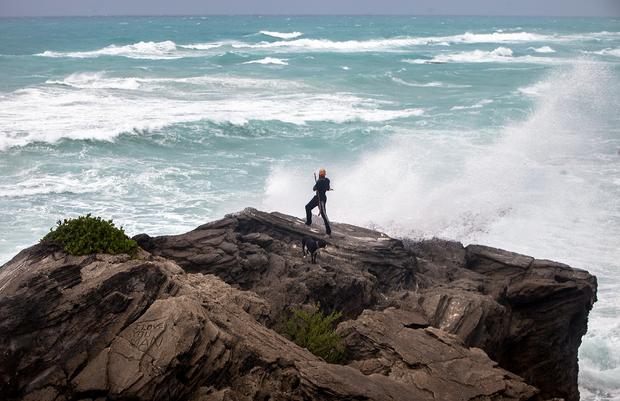Gonzalo's winds knock out power in Bermuda
HAMILTON, Bermuda -- The eye of Hurricane Gonzalo crossed over part of this tiny British territory Friday night, pounding Bermuda with fierce wind and heavy surf as a Category 2 storm that carried the threat of a dangerous storm surge.
The storm's top sustained winds were clocked at 110 mph as its core moved out to sea about 10 miles northeast of Bermuda, the U.S. National Hurricane Center said. Gonzalo was moving north-northeast at 16 mph.
Powerful gusts knocked out power on most of the island chain, according to Reuters. BermudaElectric Light Co., said nearly 31,000 customers had no electricity, out of 36,000 metered connections.
A white haze covered the island as wind uprooted trees and waves slammed into the shore. Strong winds damaged part of the roof at Bermuda's main hospital and caused water damage in the new intensive care unit, police spokesman Dwayne Caines said.
Hurricane-force winds were expected to batter Bermuda for a total of seven hours, and forecasters said the storm surge could cause significant flooding on the island about one-third the size of Washington, D.C.
"They're going to get hammered is the bottom line here," said Max Mayfield, a former director of the U.S. National Hurricane Center in Miami.
The full extent of damage wouldn't be known until sunrise.
The Bermuda Weather Service had warned residents not to go outside when the storm's calm eye moved in, but some ventured out anyway to do quick damage assessments, noting that porches were destroyed and power lines were downed.
Governor George Fergusson tweeted that a colleague saw someone driving on the road as the storm pummeled Bermuda. "Reckless in extreme," he said.
The U.S. National Hurricane Center said the storm's sustained winds were likely to slow further as Gonzalo moved away from Bermuda on a track that would take it past Newfoundland and across the Atlantic to Britain and Ireland. A tropical storm watch was issued for parts of southeastern Newfoundland.
The last major hurricane to strike Bermuda was Fabian in September 2003, a Category 3 storm that killed three police officers and another person while causing more than $100 million in damage as it tore off roofs, pulverized trees and flooded famed golf courses. It also damaged the causeway linking the airport to most of Bermuda and left tens of thousands of homes and businesses without power.
Forecasters said Gonzalo followed the same general path as Fabian and was expected to cause similar damage.
The last major hurricane to cross land in the Atlantic Basin was Hurricane Sandy in 2012, which hit Cuba as a Category 3 storm.
Bermuda has a population of roughly 70,000 and lies 850 miles east of the U.S. state of South Carolina. It has one of the highest per-capita incomes in the world and the government enforces strict building codes to ensure homes can withstand sustained winds of at least 110 mph.
Bermuda closed its schools, the international airport and the causeway, and soldiers from the Bermuda Regiment were dispatched to areas including nursing homes.
The Royal Gazette newspaper reported Friday night that firefighters had received more than 20 calls for fires, roof damage and other incidents in the early going of the storm. More than 30,000 people were without power.
A 436-foot frigate of Britain's Royal Navy with a crew of some 180 sailors was expected to arrive Sunday to help with post-storm recovery efforts.
The hurricane arrived just days after Tropical Storm Fay damaged homes and knocked down trees and power lines in Bermuda, and people stripped stores of emergency supplies as they battened down for Gonzalo.
Gonzalo swept by the eastern Caribbean earlier this week, claiming one life in the Dutch territory of St. Maarten. The hurricane center said the storm was generating large swells that could cause dangerous surf on portions of the U.S. southeast coast and those conditions would spread northward along the East Coast during the night.
In the Pacific, Ana strengthened into a hurricane as it drove toward Hawaii. It was expected to return to tropical storm strength late Saturday, when it was forecast to be near the Big Island, about 85 to 90 miles offshore to the southwest.
It was forecast to bring 40 to 50 mp winds to Honolulu on Oahu and to the Big Island's Kau, Puna and South Kona districts.
